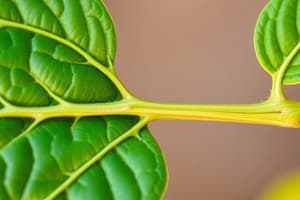Podcast
Questions and Answers
Explain how cohesion-tension theory contributes to water movement in plants.
Explain how cohesion-tension theory contributes to water movement in plants.
Cohesion-tension theory explains that water molecules stick together (cohesion) and adhere to the xylem walls (adhesion), allowing water to be pulled upward through the plant due to transpiration.
What role do companion cells play in phloem transport?
What role do companion cells play in phloem transport?
Companion cells assist sieve tube elements by actively loading sugars into the phloem, which increases sugar concentration and drives mass flow towards sinks.
Identify at least two environmental factors that influence transpiration rates in plants.
Identify at least two environmental factors that influence transpiration rates in plants.
Temperature and humidity are two environmental factors that significantly influence transpiration rates, with higher temperatures and lower humidity increasing water loss.
Discuss how stomatal behavior adjusts to water stress in plants.
Discuss how stomatal behavior adjusts to water stress in plants.
Describe how root pressure aids in water movement within plants.
Describe how root pressure aids in water movement within plants.
What are the primary functions of xylem and phloem in plant transport systems?
What are the primary functions of xylem and phloem in plant transport systems?
How does osmosis contribute to water uptake in plants?
How does osmosis contribute to water uptake in plants?
Describe the transpiration stream and its significance in plants.
Describe the transpiration stream and its significance in plants.
What role do stomata play in the regulation of water loss in plants?
What role do stomata play in the regulation of water loss in plants?
Explain how the cohesion-tension theory supports water movement in tall plants.
Explain how the cohesion-tension theory supports water movement in tall plants.
What factors affect the rate of transpiration in plants?
What factors affect the rate of transpiration in plants?
How does active transport contribute to mineral uptake in plants?
How does active transport contribute to mineral uptake in plants?
What structural adaptations do xylem vessels have for effective water transport?
What structural adaptations do xylem vessels have for effective water transport?
Flashcards
Plant Vascular Tissues
Plant Vascular Tissues
Specialized tissues (xylem and phloem) that transport water, minerals, and organic compounds throughout the plant.
Xylem
Xylem
Vascular tissue responsible for transporting water and minerals absorbed from the soil to the rest of the plant.
Phloem
Phloem
Vascular tissue responsible for transporting sugars (produced during photosynthesis) from sources to sinks (like roots, fruits or growing tissues).
Transpiration
Transpiration
Signup and view all the flashcards
Transpiration Stream
Transpiration Stream
Signup and view all the flashcards
Cohesion-Tension Theory
Cohesion-Tension Theory
Signup and view all the flashcards
Water Potential Gradient
Water Potential Gradient
Signup and view all the flashcards
Root Pressure
Root Pressure
Signup and view all the flashcards
Osmosis
Osmosis
Signup and view all the flashcards
Active Transport
Active Transport
Signup and view all the flashcards
Sieve Tube Elements
Sieve Tube Elements
Signup and view all the flashcards
Companion Cells
Companion Cells
Signup and view all the flashcards
Water Movement in Plants
Water Movement in Plants
Signup and view all the flashcards
Osmosis in Plants
Osmosis in Plants
Signup and view all the flashcards
Root Pressure
Root Pressure
Signup and view all the flashcards
Cohesion-Tension Theory
Cohesion-Tension Theory
Signup and view all the flashcards
Transpiration
Transpiration
Signup and view all the flashcards
Phloem Transport
Phloem Transport
Signup and view all the flashcards
Sieve Tubes
Sieve Tubes
Signup and view all the flashcards
Active Transport (in Phloem)
Active Transport (in Phloem)
Signup and view all the flashcards
Companion Cells
Companion Cells
Signup and view all the flashcards
Environmental Factors on Transpiration
Environmental Factors on Transpiration
Signup and view all the flashcards
Stomatal Regulation
Stomatal Regulation
Signup and view all the flashcards
Water Stress and Drought
Water Stress and Drought
Signup and view all the flashcards
Plant Adaptations to Conserve Water
Plant Adaptations to Conserve Water
Signup and view all the flashcards
Study Notes
Transport Systems in Plants
- Plants, unlike animals, lack a circulatory system. Instead, they rely on specialized vascular tissues to transport water, minerals, and organic compounds.
- Xylem and phloem are the two primary vascular tissues responsible for long-distance transport.
- Xylem transports water and minerals absorbed from the soil to the rest of the plant.
- Phloem transports sugars (produced during photosynthesis) from sources (like leaves) to sinks (like roots, fruits, or growing tissues).
- Water uptake occurs primarily at the roots through osmosis and facilitated diffusion.
- Water potential gradients drive water movement throughout the plant. Water enters the root hairs and travels through the cortex, endodermis, and vascular cylinder.
- Mineral uptake is also facilitated by active transport across cell membranes, requiring energy.
- The transpiration stream is the continuous flow of water through the xylem, driven by transpiration from leaves.
- Transpiration is the loss of water vapor from leaves through stomata.
- Factors affecting transpiration include light intensity, temperature, humidity, and wind speed.
- Stomata open and close to regulate water loss and gas exchange.
- Root pressure plays a role in pushing water up the plant, especially in small plants and at night.
- Cohesion-tension theory explains the upward movement of water in tall plants, primarily due to the cohesion of water molecules and the tension created by transpiration pull.
- Xylem vessels are specialized cells arranged end-to-end, creating continuous tubes for water transport.
- Xylem vessels have a lignin-containing wall that provides structural support and resistance to the high tension of water transport.
- Phloem transport is driven by differences in osmotic pressure between source and sink regions.
- Active transport in phloem loading moves sugars from mesophyll cells to sieve-tube elements.
- Bulk flow in phloem occurs through sieve tubes, assisted by companion cells pumping sugars in and out to create pressure differences.
Mechanisms of Transport
- Water transport involves a network of interconnected vessels, including xylem and phloem (vascular bundles).
- Xylem vessels are hollow tube-like cells with thick cell walls stiffened by lignin for the unidirectional transport of water and minerals (water absorption).
- Water movement occurs via:
- Osmosis (water moving from high to low potential)
- Root pressure (pushing water up xylem)
- Cohesion-tension theory (pulling water up from transpiration):
- Water molecules are cohesive, allowing chain-like movement.
- Adhesive forces between water molecules and xylem walls further maintain the pull.
- Transpiration (loss of water vapor through leaves).
- Phloem transport occurs via sieve tubes, which are elongated cells with sieve plates (perforations or gaps) to facilitate the transport of sucrose (a sugar).
- This movement requires energy due to the need to move sugars from source to sink via active transport (and subsequent flow via mass flow).
- Companion cells are closely associated with sieve tube elements.
- Active transport loads sugars into the phloem, increasing the concentration and lowering the water potential in the phloem.
- Water moves into the phloem from the xylem, creating turgor pressure that drives the mass flow of sugars from source to sink.
Factors Influencing Plant Transport
- Environmental factors such as temperature, humidity, light intensity, and wind speed directly impact transpiration rates.
- High temperatures and low humidity increase transpiration.
- Strong winds also increase transpiration as they remove water vapor from the leaf surface.
- Stomatal opening and closing regulate gas exchange for photosynthesis and water loss, influenced by factors such as light(open), darkness (close), and water availability.
- Water stress and drought conditions lead to stomatal closure to conserve water.
- Different plant species have adaptations to conserve water in arid environments, like reduced leaf surface area, thick cuticles, or specialized stomatal patterns.
Studying That Suits You
Use AI to generate personalized quizzes and flashcards to suit your learning preferences.




